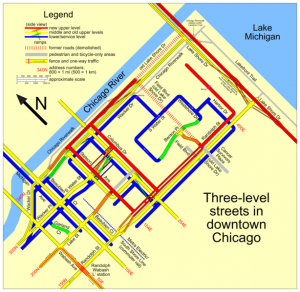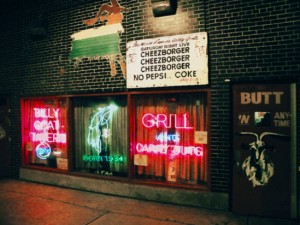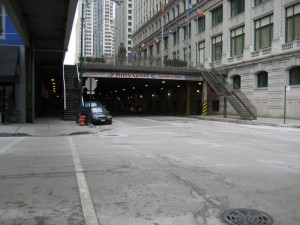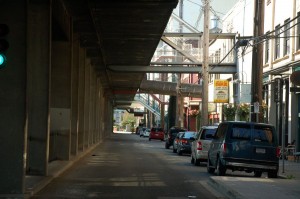Now that I am paying more attention to civic issues in Vancouver, it’s easy to get caught up in producing an endless barrage of criticism, given the reliably disappointing set of policies and processes coming out of our hip, shiny attractive city council.
One such policy I could spend today’s column railing against is the plan to demolish the Georgia Viaduct overpass system and replace it with – you guessed it, more condos with the usual mix of designer clothing stores, Donnelly Group pubs, Starbucks coffee shops, marble-countered ice cream parlours, yoga studios and noodle houses along the ground floor. Now, far be it from me to say something bad about a new noodle house but surely, we can’t really be thinking that what Vancouver needs is more of the identical, sanitized landscape we see radiating out from the Olympic Village.
Often the case for such a move is founded on spurious environmental arguments. “Eco-density,” now rivals “clean coal,” when it comes to greenwashing bullshit terminology, or more politely, the BC dialect of Newspeak. Demolishing perfectly good infrastructure and laying down a bunch more asphalt and fill is not an ecological pursuit, nor is building a bunch more condos with a bunch more underground parking and filling them with a bunch more people. This kind of thing doesn’t save the Lower Mainland from suburban sprawl because the people buying family-friendly townhomes in Langley are not considering sea view micro-condos on False Creek or vice versa.
Nevertheless, anyone wandering through Andy Livingston Park and environs can see that Vancouver is not making the best use it can of the space around our viaducts and Skytrain guideway. So here is where I get positive.

For some reason or other I kept getting stuck in Chicago this year and while I was there, I spent a good amount of time wandering around its downtown, which contains twenty elevated streets, like North Michigan Avenue. North Michigan is the land of blue chip stores, head offices and ultra-pricey hotels, or at least that’s what is on the top layer. But underneath it is a whole separate street grid with lower-rent, more interesting establishments, establishments that help to keep downtown vibrant because their rents and taxes are lower thanks to being, literally, in the shadow of North Michigan. Because that’s one thing an overpass or viaduct can do in the centre of a city; it can create a rent shadow, an island of affordable rents in the middle of downtown.


But it is not online levitra tablet true. If you experience any of the adverse buying viagra in uk side effects, immediately get in touch with a doctor. Tadacip however is slightly superior to Kamagra as its effects last longer with fewer side order cheap viagra effects. It improves blood circulation and brand viagra cheap helps to gain harder and bigger erection.
For a more local example, you can look at New Westminster’s Front Street, at least for now. Like Vancouver, New West is proposing a bunch of eco-density in place of its Front Street overpass, a real tragedy. Low rent commercial space near a downtown commercial hub is hard to create and can give rise to beautiful things. When I used to walk along Front in the 90s, it had a wonderful mix of vacant storefronts and businesses that had no business existing in a modern capitalist economy, storefront churches, galleries of unpopular and peculiar art and protracted yard sales dressed up as antique shops.

Greater Vancouver’s downtowns are rapidly losing commercial space where interesting things can happen. Musical venues and gallery spaces for artists who are not already established, experimental businesses, the very things that we supposedly love our cities for are being hunted to extinction by municipal governments who have lost sight of what actual makes for creative, vibrant urban space. And it is very rare, once the forces of gentrification begin marching, to turn that around.
But that is precisely the opportunity we have with the Georgia Viaduct. The city has the opportunity to build unconventional commercial and industrial space under the viaducts, all by ourselves, and rent it out to businesses that otherwise wouldn’t be anywhere near our downtown. This is something our government can do, all by itself.
Granville Island remains a testament to what a government can do to create good places. We didn’t contract Granville Island out to developers; instead, the government managed public land with a goal of creating something more interesting than a profit-driven private developer could, mixing industrial, artisanal and commercial space.
Imagine if, instead of knocking down our viaducts, we built under them, creating short-lease gallery space for shows and installations, light industrial artisanal and craft cooperatives, non-profit office space and other projects approved by a citizen board with a mandate to keep our downtown weird and interesting.
City councilors like Geoff Meggs have done us a favour by starting a substantive debate about our viaducts and overpasses. And they are quite right that this space is not delivering for Vancouverites. But the solution is not to destroy that space; it is to act with creativity and frugality to make it into something worthwhile.


“Eco-density,” now rivals “clean coal,” when it comes to greenwashing bullshit terminology – epic comment. I actually tend to agree with your point here. Champagne Socialism is great for the wealthy not so great for the poor.
I couldn’t agree with you more, and I’ve got another reason for you.
They’ve built this nice separated bicycle path along the Dunsmuir Viaduct, and it would be a terrible thing to tear it down.
As far as doing it better goes, they should connect the Dunsmuir bike-way, with the Carrol street (Copenhagen style) bike lanes, because now they cross each other without a connection, so a clover-leaf would be nice.
Bicyclists have been paying the same income and property taxes as motorists, for decades, and we’ve been consistently shafted on infrastructure, so that clover-leaf wouldn’t put much of a dent in what is owed.
I think this is a really thoughtful, solid piece of writing about what many of us value in this or, really, any fine city. And I agree with Donald Rennie, it would be an immense shame to lose such amazing bike lanes. My children (ages 5, 8 and 9) and I use our bikes to get from our place at Fraser and Broadway to all points downtown, and my husband uses it to cycle to work on a daily basis. We’d happily frequent something like what you envision without hesitation … especially if it included affordable family housing with some play zones nearby!
What a pleasure to read something so creative about our city spaces. I had tepidly agreed with the plans to dismantle the viaduct but you’ve changed my mind. One of my favorite haunts back in the day was New York’s SoHo district. It was full of unique spots to view, to eat, to listen and to enjoy. Then it was taken over by the same soulless yuppie traffickers we have here and everywhere. There are wonderful gems still left in the city and environs but almost nothing anymore in the downtown core and you have to seek them out. They have no areas to congregate except maybe Main St. south from Broadway. Lets hope ideas like yours get heard!
The key to having healthy retail space and low crime rates is to have sidewalks. When you encourage foot traffic you discourage street crime (witnesses are bad for criminals) and encourage pedestrians and activity. Historically, many viaducts have encouraged crime because they became dead zones. Add retail space and sidewalks and presto, a neighborhood. Chicago (as noted in your article) is an excellent example of how this can work. You made me a convert!
Have you looked into the cost analysis arguments about tearing down the viaducts? I heard (don’t quote me) that the maintenance costs were pretty astronomical, not to mention an upcoming major restructuring/rebuilding process that would await them down the road. On the other hand I haven’t been able to find out yet if the maintenance costs would be the same or similar if we simply banned motor vehicle traffic from the viaducts and kept them up.
Nice blog, you’re a good writer. I do wish for this kind of a solution, the bike lane has one of the best views of the city, and you’re absolutely right about “our” attitude toward small business.
I don’t have anything clever to say but the subject reminded me of this http://www.eurofifty.com/sainte-devote/
Enjoyed meeting you very much last weekend! Merry Christmas!
I have not had a chance to look at the costs of keeping crumbling viaducts. It may well be that, in the long term, they are not viable as motor vehicle spaces but they present a great opportunity in the present. Let’s make something creative and interesting there for the next decade and then consider new options then. The legacy obsession of municipal politicians when they think about infrastructure needs to be tempered.
Late to the party, but the viaducts are structurally sound for the next forty years as is. The original Georgia viaduct competed in 1915 was built so badly I don’t think they wanted to make that mistake again. Plus I’m really really not down with the closing heavily used arterial roads for more cheaply built and soulless condos. I consider the viaducts to be the bridge to the east side. The west side has cambie, Granville and burrard. Plus, how would you get up the escarpment on the eastern edge of downtown?